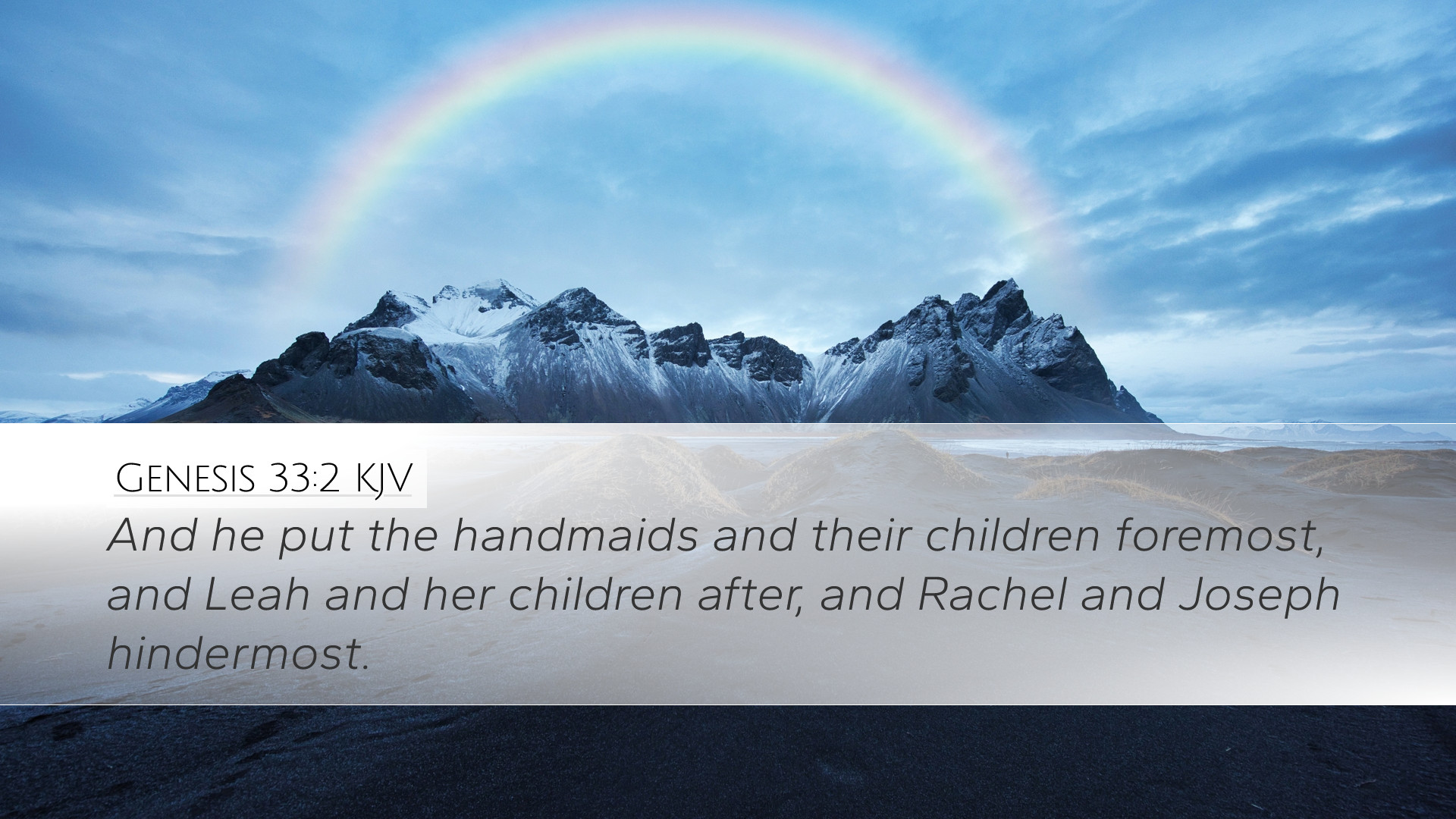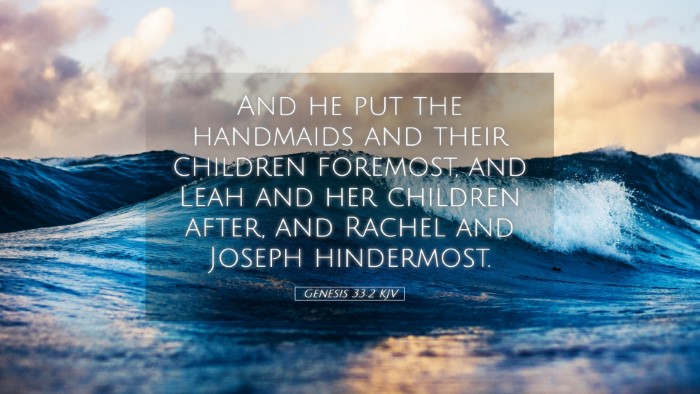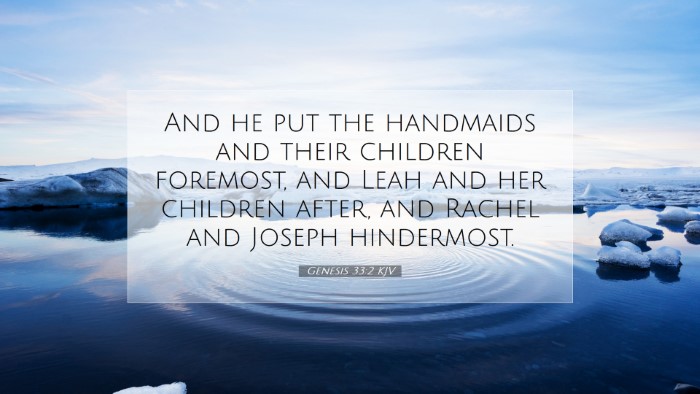Commentary on Genesis 33:2
Genesis 33:2 (KJV): "And he put the handmaids and their children foremost, and Leah and her children after, and Rachel and Joseph hindermost."
Contextual Background
In the narrative of Genesis, this verse occurs in a pivotal moment of reconciliation between Jacob and Esau. After years of separation and conflict, Jacob returns to the land of promise, apprehensive about encountering his brother who he had wronged. This passage illustrates Jacob's complex family dynamics and his strategic approach to facing Esau.
Commentary Overview
Various commentaries illuminate the theological and practical implications of this verse:
Matthew Henry's Commentary
Matthew Henry focuses on Jacob's careful arrangement of his family as a blend of prudence and protective instinct. Jacob places the handmaids and their children foremost, which may suggest a desire to safeguard his favored family members, namely Rachel and Joseph. This practice showcases Jacob’s understanding of societal hierarchies and his attempt to present himself before Esau in a way that reflects humility while still retaining the respect toward his favorite wife and child.
Key Insights:
- Hierarchy of Relationships: The arrangement illustrates Jacob’s perception of the importance of relationships within his family. The handmaids and their children, being of lesser status in Jacob's eyes, are placed at the front to potentially absorb any hostility from Esau.
- Strategic Protection: By placing Rachel and Joseph at the rear, Jacob demonstrates a protective instinct, emphasizing the significance he places on their safety above all.
Albert Barnes' Notes on the Bible
Albert Barnes notes that this act of positioning the family can be seen as both a tactical move and a reflection of Jacob's past experiences. He believes that Jacob, knowing Esau's temperament, fears for those he loves the most.
Key Insights:
- Fear and Faith: Barnes points out the tension between Jacob's faith in God’s promises and his fear of Esau’s potential anger. This arrangement reflects a dual reality in Jacob’s life—trust in divine protection yet also a reluctance to face personal accountability.
- Role of Women in Patriarchal Society: The arrangement presents a disturbing view on the status of women in the cultural context, as the handmaids and Leah are not positioned in the same regard as Rachel, leading to discussions about biblical gender roles.
Adam Clarke's Commentary
Adam Clarke emphasizes the emotional nuances of the moment. He describes Jacob's actions as reflective of his past interpersonal conflicts and the necessity to display a semblance of order and submission to his brother, which indicates deep-rooted relational complexities.
Key Insights:
- Emotional Tension and Resolve: Clarke articulates how Jacob's actions bring attention to the emotional turmoil he faces. Despite having wrestled with God and having been blessed, his human fears still influence his decisions.
- Foreshadowing of Future Relationships: The arrangement and the resulting encounter with Esau serves as a foreshadowing of the future dynamics within Jacob's family, illustrating the long-standing conflicts that would revisit them through the generations.
Theological Reflections
Genesis 33:2 offers rich theological reflections relevant for pastors and theologians. It invites contemplation on the relationship between faith and fear, as well as family dynamics within a covenant context.
Faith Amidst Fear
The juxtaposition of Jacob's trust in God's promise and his fear of Esau encapsulates the human condition. This passage serves as a reminder that faith does not eliminate fear; rather, it provides a framework to approach fears with caution and wisdom. Jacob's strategy can be viewed as a reflection of God's call to engage with the world realistically while maintaining trust in His providence.
Family Dynamics
The structuring of Jacob's family highlights the complexity of familial relationships. This arrangement may stir discussions regarding favoritism, jealousy, and the societal implications of such dynamics. The different statuses of his wives and their children can lead to broader discussions on how family structures influence personal identity and community interactions.
Cultural Context and Gender Roles
The placement of the handmaids and Leah raises critical conversations around the roles and status of women in biblical narratives. It invites reflection on how these dynamics can shape our understanding of gender within scriptural texts and prompts questions regarding how this understanding informs contemporary discourse on gender equality in faith communities.
Conclusion
Genesis 33:2 stands as a profound verse that encapsulates the interplay of familial loyalty, fear, and the quest for reconciliation. The commentary insights from Matthew Henry, Albert Barnes, and Adam Clarke provide a multifaceted approach to understanding not just the historical narrative but the enduring spiritual and relational principles that resonate with believers today. For pastors, students, theologians, and scholars, this verse beckons deeper investigation into its implications for personal faith and community life.


